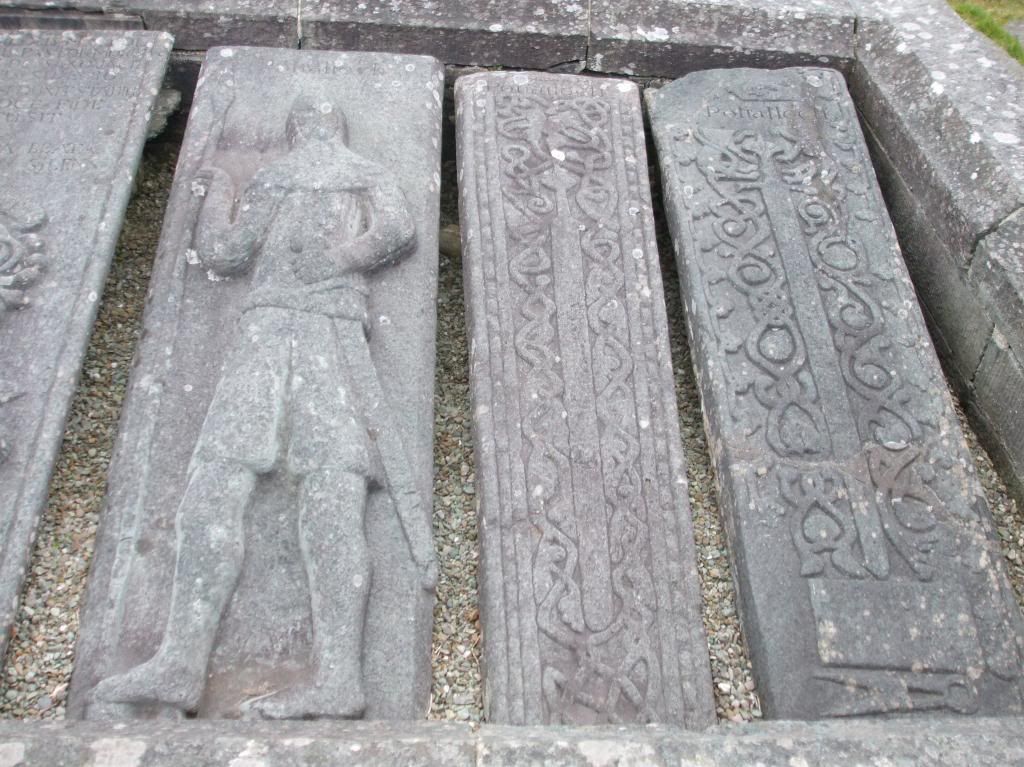Kilmartin Parish Church - The Malcolms of Poltalloch
I talked a little about the modern appropriation of late medieval graveslabs yesterday, and I can find no better illustration of this than in the second group of medieval sculptured stones at Kilmartin.
These unfortunate examples are condemned to hang around outside in the wind and the rain, unlike their compatriots which are sheltered in the lapidarium. They're very fine examples, and they certainly don't seem to suffering unduly through this ill-treatment. But the reason for their apparent neglect is an entirely practical one: every stone in this collection has been requisitioned by the Malcolms of Poltalloch and re-used as a burial marker for members of the Malcolm family.

We're already familiar with the warrior in his helmet and quilted aketon. I haven't however, featured any of the stones which show swords surrounded by foliate decoration. We get similar grave markers down in the south-west, though I think I'm right in saying that here the foliate decoration isn't quite so elaborate. Popular tradition tends to ascribe them to 'templar' burials in south-west Scotland, though I'd venture to suggest that knightly symbolism does not a Templar make...
What strikes me as curious in these particular stones are the association (see the stone on the right) of a knightly symbol - the sword - with objects that are more mundane, i.e. the pair of shears and what appears to be a meat cleaver.
What does this mean? Are the shears something to do with the clipping of the beard or the hair? Is the cleaver something to do with butchery (or surgery? Perhaps this is the army medic!!!)
Unfortunately I have no answers to this conundrum, but the possibilities certainly are entertaining...
As for the Malcolms of Poltalloch... They play an important part in our story because they were the landowners throughout the Kilmartin Glen during much of the post-Improvement period in the 18th and 19th centuries. If they hadn't embraced the mysterious 'druidical' remains which proliferate throughout the area and absorbed them into the designed landscape which formed part of their estate, then the Bronze Age 'ritual landscape' which I'll introduce you to very shortly would never have survived to the present...
These unfortunate examples are condemned to hang around outside in the wind and the rain, unlike their compatriots which are sheltered in the lapidarium. They're very fine examples, and they certainly don't seem to suffering unduly through this ill-treatment. But the reason for their apparent neglect is an entirely practical one: every stone in this collection has been requisitioned by the Malcolms of Poltalloch and re-used as a burial marker for members of the Malcolm family.

We're already familiar with the warrior in his helmet and quilted aketon. I haven't however, featured any of the stones which show swords surrounded by foliate decoration. We get similar grave markers down in the south-west, though I think I'm right in saying that here the foliate decoration isn't quite so elaborate. Popular tradition tends to ascribe them to 'templar' burials in south-west Scotland, though I'd venture to suggest that knightly symbolism does not a Templar make...
What strikes me as curious in these particular stones are the association (see the stone on the right) of a knightly symbol - the sword - with objects that are more mundane, i.e. the pair of shears and what appears to be a meat cleaver.
What does this mean? Are the shears something to do with the clipping of the beard or the hair? Is the cleaver something to do with butchery (or surgery? Perhaps this is the army medic!!!)
Unfortunately I have no answers to this conundrum, but the possibilities certainly are entertaining...
As for the Malcolms of Poltalloch... They play an important part in our story because they were the landowners throughout the Kilmartin Glen during much of the post-Improvement period in the 18th and 19th centuries. If they hadn't embraced the mysterious 'druidical' remains which proliferate throughout the area and absorbed them into the designed landscape which formed part of their estate, then the Bronze Age 'ritual landscape' which I'll introduce you to very shortly would never have survived to the present...